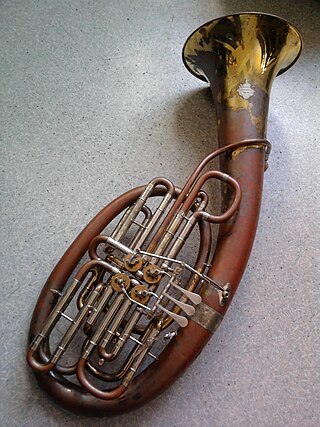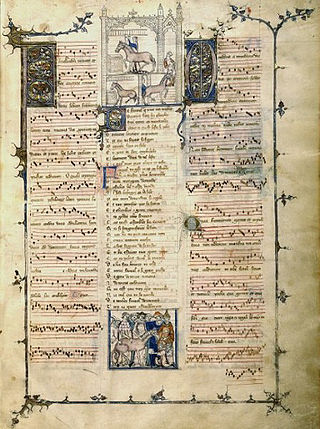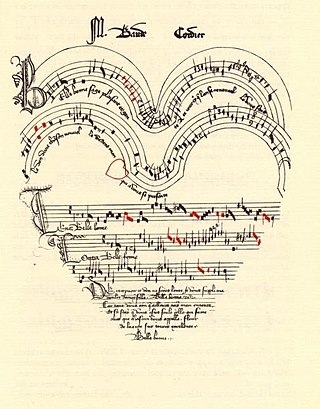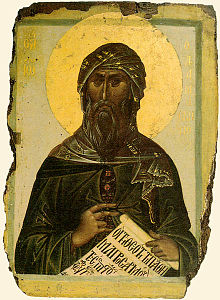
Although definitions of music vary wildly throughout the world, every known culture partakes in it, and it is thus considered a cultural universal. The origins of music remain highly contentious; commentators often relate it to the origin of language, with much disagreement surrounding whether music arose before, after or simultaneously with language. Many theories have been proposed by scholars from a wide range of disciplines, though none has achieved broad approval. Most cultures have their own mythical origins concerning the invention of music, generally rooted in their respective mythological, religious or philosophical beliefs.

The Wagner tuba is a four-valve brass instrument commissioned by and named after Richard Wagner. It combines technical features of both standard tubas and French horns, though despite its name, the Wagner tuba is more similar to the latter, and usually played by horn players. Wagner commissioned the instrument for his four-part opera cycle Der Ring des Nibelungen, where its purpose was to bridge the acoustical and textural gap between the French horn and trombone.

Ars nova refers to a musical style which flourished in the Kingdom of France and its surroundings during the Late Middle Ages. More particularly, it refers to the period between the preparation of the Roman de Fauvel (1310s) and the death of composer Guillaume de Machaut in 1377. The term is sometimes used more generally to refer to all European polyphonic music of the fourteenth century. For instance, the term "Italian ars nova" is sometimes used to denote the music of Francesco Landini and his compatriots, although Trecento music is the more common term for the contemporary 14th-century music in Italy. The "ars" in "ars nova" can be read as "technique", or "style". The term was first used in two musical treatises, titled Ars novae musicae by Johannes de Muris, and a collection of writings attributed to Philippe de Vitry often simply called "Ars nova" today. Musicologist Johannes Wolf first applied to the term as description of an entire era in 1904.
Abū Isḥāq Ibrāhīm al-Mawṣilī was an Arab musician of Persian origin who was among the greatest composers of the early Abbasid period. After Arab and Persian musical training in Ray, he was called to the Abbasid capital of Baghdad where he served under three successive Abbasid caliphs: Al-Mahdi, Al-Hadi and Harun al-Rashid. He became particularly close with the latter and emerged as the leading musician of his time. He championed the conservative school of Arab music against progressives such as Ibn Jami. His son and student Ishaq al-Mawsili would succeed him as the leader of the conservative tradition and his other pupils included the musicians Mukhariq, Zalzal and Ziryab. He appears in numerous stories of One Thousand and One Nights.

Baude Cordier was a French composer in the ars subtilior style of late medieval music. Virtually nothing is known of Cordier's life, aside from an inscription on one of his works which indicates he was born in Rheims and had a Master of Arts. Some scholars identify him with Baude Fresnel, a harpist and organist in the court of Philip the Bold, though other scholars have rejected this.
Manṣūr Zalzal al-Ḍārib or simply Zalzal, was an Iranian musician during the early Abbasid period. The renowned musician Ishaq al-Mawsili was his student; he declared Zalzal to be the most outstanding lutenist of his time.

Carl Michael Alfred Steinberg was an American music critic and author who specialized in classical music. He was best known, according to San Francisco Chronicle music critic Joshua Kosman, for "the illuminating, witty and often deeply personal notes he wrote for the San Francisco Symphony's program booklets, beginning in 1979." He contributed several entries to the New Grove Dictionary of Music and Musicians, wrote articles for music journals and magazine, notes for CDs, and published a number of books on music, both collected published annotations and new writings.
John Kladas was a Byzantine composer. He had the post of lampadarius in the cathedral of Hagia Sophia of Constantinople. He wrote several works on the theory of music, the most important being the Grammatike tes mousikes.

Trevor Noël Goodwin was an English music critic, dance critic and author who specialized in classical music and ballet. Described as having a "rare ability to write about music and dance with equal distinction", for 22 years Goodwin was Chief music and dance critic for the Daily Express. He held criticism posts at many English newspapers, including the News Chronicle, Truth and The Manchester Guardian among others; from 1978 to 1998 he also reviewed performances for The Times. Goodwin wrote an early history of the Scottish Ballet and was coauthor for two books: London Symphony: Portrait of an Orchestra with Hubert J. Foss and a Knight at the Opera with Geraint Evans.
Nicola Sabini was an Italian composer of the mid-Baroque period who spent his career in Naples. An influential figure in early Neapolitan opera buffa, his most important opera is the 1701 comedy Scherzo drammatico, Il mondo abbattuto.
Jacob J. Sawyer (1856–1885) was an American composer, pianist, songwriter, and conductor. His Welcome to the Era March (1877) was included in James Monroe Trotter's Music and Some Highly Musical People (1878).
David Hiley is an English musicologist. He specializes in early music, particularly plainchant, early polyphony and English music.







